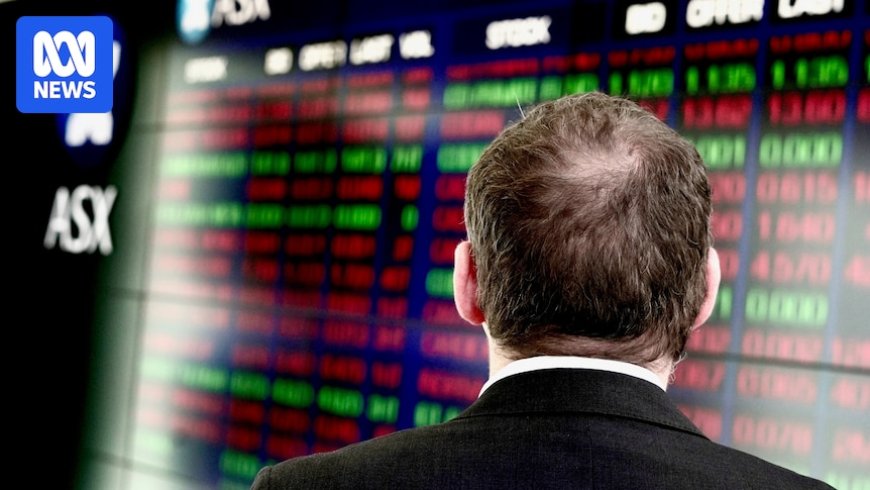ASX 200 Surges 10% in Financial Year 2025 Despite Global Uncertainties
The ASX 200 index gained 10.2% in the financial year 2024/25, reaching 8,542 points. Despite geopolitical tensions and market volatility, Australian stocks performed well. Major conflicts and oil price surges impacted market movements. US investors favored Australian banking stocks, while technology sectors saw growth. Experts predict continued gains in the market, driven by strong profit growth and central bank rate cuts.

For all the turbulence on the Australian stock market in recent months, you wouldn't have known it on June 30.
It was a strong session on Monday, before a late wobble saw the S&P/ASX 200 post a modest rise of a third of a per cent — cementing a 10.2 per cent gain for the financial year.
Over the last five days, the local benchmark index has gained 0.4 per cent and is currently about 1.1 per cent off its 52-week high.
The Australian share market performed remarkably well in financial year 2024/25 — the ASX 200 index began the financial year at 7,750 index points and closed it 8,542.
The past 12 months have seen major conflicts continue, including wars between Russia and Ukraine, Israel and Hamas, and most recently Israel and Iran.
The Australian dollar falls heavily against the US dollar, losing 1 per cent against the greenback in the space of a couple of hours on the news of Israel's air strikes on Iran.
The latter also saw incredible price volatility in oil markets, with the price of Brent crude surging 14 per cent at one point, only to fall back by the same amount following the declaration of a ceasefire.
Any major oil price surge had the potential to spark a renewed inflation outbreak, interest rate hikes and a global recession.
It would have taken nerves of steel to hold a long position in the equity markets — that is, hold onto shares rather than sell out to reduce risk — and yet, many did.
Many also piled into stocks after they fell.
The Australian share market also became known throughout financial year 2025 as something of a 'safe haven' investment opportunity.
Investors from the United States, in particular, piled into Australian banking stocks.
'Defensive buying from US and overseas investors pushed banks and large cap stocks like Wesfarmers and CommBank to all-time highs,' Ms Ecuyer said.
'Gold miners shot the lights out, up over 50 per cent, while slowing China growth and macroeconomic impact of tariffs dragged down materials and energy stocks into negative territory.'
'Investors should be super happy with such a great result,' Ms Ecuyer said.
'It has been a good year all round,' Marcus Today senior portfolio manager Henry Jennings agreed.
'Close to record highs despite the volatility and the uncertainty.'
CBA shares have gained more than 46 per cent over the past 12 months.
The Australian financials index finished up 23 per cent for the financial year.
So where to now for shares?
Rather than investors relishing in a bullish trading environment, where buying enthusiasm overwhelms the markets, investors have been climbing a so-called 'wall of worry.'
'Fortunately, Trump backed down on the worst of his tariffs for now and the Middle East threat has fizzled seeing US shares rise to a new record high.
'Australian shares closed the financial year just 0.9 per cent below their record high and on track for another financial year of strong returns for 2024-25 helped by strong profit growth in the US and central bank rate cuts elsewhere, including in Australia.'
Every Australian with superannuation benefits from this rise in the value of share markets.
Indeed, an average wage earner would have added or earned close to $20,000 on to their superannuation balance over the past 12 months, assuming they were all-in on Australian shares.
The superannuation sector itself is now worth well over $4 trillion.
From today, the superannuation guarantee rate will increase from 11.5 per cent to 12 per cent.
The yield on US 30-year Treasury bonds has been trading above 4.8 per cent now for two months. Yields rise when bond prices fall.
'A US public debt crisis is the main threat to the bond market,' Dr Oliver said.
'But however the share market performs over the next 12 months, it is likely to be a bumpy ride,' he said.
'Share market volatility is likely to remain high in the next few months given tariff uncertainties, concerns about US debt and likely weaker growth and profits.
'But with Trump likely to pivot towards more market-friendly policies and central banks, including the Federal Reserve and the RBA, likely to cut interest rates further, shares are likely to provide reasonable gains into year end.'
'A loss of confidence in any global central bank, with share markets at record highs, is a rather scary thought and a recipe for further volatility heading into the new financial year.'
What's Your Reaction?
 Like
0
Like
0
 Dislike
0
Dislike
0
 Love
0
Love
0
 Funny
0
Funny
0
 Angry
0
Angry
0
 Sad
0
Sad
0
 Wow
0
Wow
0
















































































































































